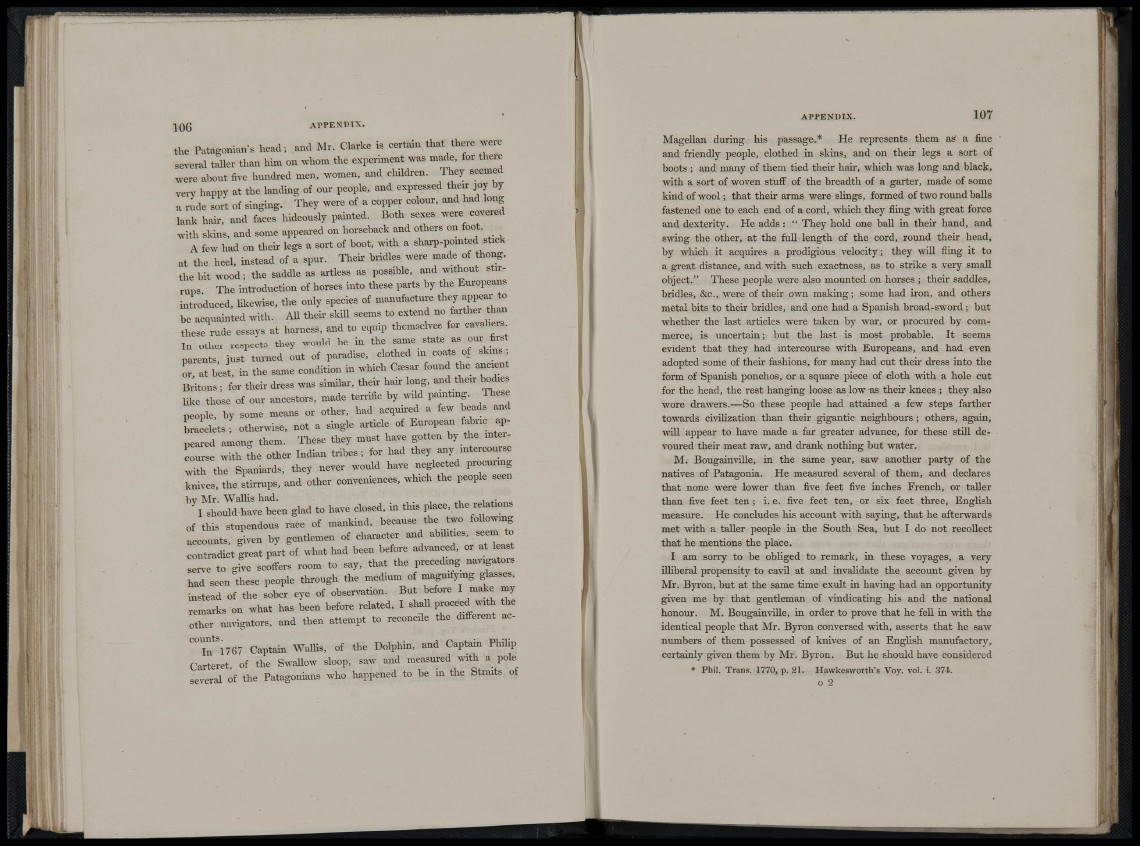
lOG APPEN-DIX.
the Patagonian-s head; and Mr. Clarke is certain that there we.e
several taller than him on whom the experiment was made, for there
were about five hundred men, women, and children. ITiey seemed
very happy at the lancUng of our people, and expressed their joy by
a rude sort of singing. They were of a copper colour, and had long
lank hair, and faces hideously painted. Both sexes were covered
with skins, and some appeai-ed on horseback and others on foot.
A few had on their legs a sort of boot, with a sharp-pomted stick
a t the heel, instead of a spur. Tlieii- bridles were made of thong,
the bit wood; the saddle as artiess as possible, and without stirrups
The introduction of horses into these parts by the Europeans
in roduced, hkewise, the only species of manufacture they appe^ to
be acquainted with. AU their skill seems to extend
these rude essays at harness, and to equip themselves for cavahers
In other respects they would be in the same state as our firs
parents, just tm-ned out of paradise, clothed m coats of skins
L at best, in the s ^ e condition in which C.sar found the —
Britons; for their dress was simUai-, their hair long, and then: bodies
Uke those of our ^cestors. made ten-ific by wiM p * . Tliese
people, by some means or other, had acquued a few beads n^l
L c e l e t s otherwise, not a single article of Europe^ fabric appealed
among them. These they must have gotten by the inter-
L r s e with the other Indimi tribes; for had they any intereoui-se
with the Spaniards, they never would have neglected procuring
knives, the ¡tirrups, ^ d other conveniences, which the people seen
^ ^ I ^ o S l ^ e t n glad to have .osed, in this P - ^ h e relaj ^
of this stupendous race of mankind, because the two following
l o u n t s <^ven by gentlemen of character and abilities, seem to
r ^ c t ^ r e a t pL'of what had been before advanced, or at least
s e l to gi^e s c L r s room to say, that the precedmg na^.gators
had seen these people through the medium of magnifymg glasses.
L t e a d of the sober eye of observation. But before I make my
reinai-ks on what has been before related. I shall proceed with the
o t t e na.ngators. and then attempt to reconcile the different ac-
' ° i r i 7 6 7 Captain Waffis, of the Dolphin, and Captain PhiUp
Carteret of the Swallow sloop, saw and measured with a pole
several of the Patagonians who happened to be in the Straits of
APPENDIX. 107
Magellan during his passage.* He represents them as a fine
and friendly people, clothed in skins, and on their legs a sort of
boots ; and many of them tied their hair, which was long and black,
with a sort of woven stuff of the breadth of a garter, made of some
kind of wool ; that their arms were slings, formed of two round baUs
fastened one to each end of a cord, which they fling with great force
and dexterity. He adds : " They hold one ball in their hand, and
swing the other, at the fuU length of the cord, round their head,
by which it acquires a prodigious velocity; they will fling it to
a great distance, and with such exactness, as to strike a very small
object." These people were also mounted on horses ; their saddles,
bridles, &c.. were of their own making; some had iron, and others
metal bits to their bridles, and one had a Spanish broad-sword; but
whether the last articles were taken by war, or procured by commerce,
is uncertain; but the last is most probable. It seems
evident that they had intercourse with Europeans, and had even
adopted some of their fashions, for many had cut their dress into the
form of Spanish ponchos, or a square piece of cloth with a hole cut
for the head, the rest hanging loose as low u s their knees ; they also
wore drawers.—So these people had attained a few steps farther
towards civilization than their gigantic neighbours ; others, again,
will appear to have made a far greater advance, for these stiU devoured
their meat raw, and drank nothing but water.
M. Bougainville, in the same year, saw another party of the
natives of Patagonia. He measured several of them, and declares
that none were lower than five feet five inches French, or taller
than five feet ten ; i. e. five feet ten, or six feet three, English
measure. He concludes his account with saying, that he afterwards
met with a taller people in the South Sea, but I do not recollect
that he mentions the place.
I am sorry to be obliged to remark, in these voyages, a very
iUiberal propensity to cavil at and invalidate the account given by
Mr. Byron, but at the same time exult in having had an opportunity
given me by that gentleman of vindicating his and the national
honour. M. Bougainville, in order to prove that he fell in with the
identical people that Mr. Byron conversed with, asserts that he saw
numbers of them possessed of knives of an Enghsh manufactory^,
certainly given them by Mr. Byron. But he should have considered
• Phil. Trans. 1770, p. 21. Hawkeswortli's Voy. vol. i. S74,.
o 2